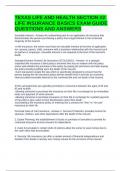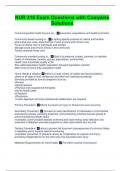-
1. Exam (elaborations) - Ch 3 life insurance policies part 1 final exam insurance texas life and health insura...
-
2. Exam (elaborations) - Chapter #8 - texas life and health exam questions and answers
-
3. Exam (elaborations) - Chapter 6: texas statutes and rules pertaining to life and health insurance exam ques...
-
4. Exam (elaborations) - Day 01: texas ple - life and health insurance test questions and answers
-
5. Exam (elaborations) - Day 02: texas pre-licensing education - life and health insurance exam questions with...
-
6. Exam (elaborations) - Final exam - texas life and health questions with complete solutions
-
7. Exam (elaborations) - Final exam life & health insurance texas q&a
-
8. Exam (elaborations) - Guarantee exam life and health insurance texas questions with correct answers
-
9. Exam (elaborations) - Ins.texas statutes and rules common to life and health insurance exam questions with ...
-
10. Exam (elaborations) - Insurance license practice xcel solutions final exam #12 - texas life questions and a...
-
11. Exam (elaborations) - Life & health insurance exam-texas questions and answers
-
12. Exam (elaborations) - Life insurance exam question (texas) and answers
-
13. Exam (elaborations) - Missed and guessed questions from texas life and health insurance exam questions and ...
-
14. Exam (elaborations) - Practice exam of texas life & health insurance. "section 1- texas common law" questio...
-
15. Exam (elaborations) - Practice exam of texas life & health insurance. "health section #1" exam questions wi...
-
16. Exam (elaborations) - Practice exam of texas life & health insurance. "section 2- texas life law" exam revi...
-
17. Exam (elaborations) - Primerica: texas life agent exam review questions with complete answers
-
18. Exam (elaborations) - Simulator texas life and health exam review questions with complete answers
-
19. Exam (elaborations) - Texas (life & health) chapter #3 exam questions with correct answers
-
20. Exam (elaborations) - Texas final exam health & life insurance guide questions with complete answers
-
21. Exam (elaborations) - Texas general lines - life, accident and health insurance practice exam questions and...
-
22. Exam (elaborations) - Texas group 1 life and health insurance section #2 exam questions with correct answer...
-
23. Exam (elaborations) - Texas health and life chapter #2 questions and answers
-
24. Exam (elaborations) - Texas health and life insurance (basic principles) exam questions and answers
-
25. Exam (elaborations) - Texas health and life insurance exam fx questions and answers
-
26. Exam (elaborations) - Texas health and life insurance exam questions with complete solutions
-
27. Exam (elaborations) - Texas health insurance exam 2023/2024 questions and answers
-
28. Exam (elaborations) - Texas health insurance practice exam questions and answers
-
29. Exam (elaborations) - Texas insurance exam questions and answers
-
30. Exam (elaborations) - Texas life agent exam question and answers
-
31. Exam (elaborations) - Texas life and health - chapter #5 field underwriting procedures exam questions and a...
-
32. Exam (elaborations) - Texas life and health exam questions with verified answers
-
33. Exam (elaborations) - Texas life and health final exam questions and answers
-
34. Exam (elaborations) - Texas life and health final exam review questions with complete solutions
-
35. Exam (elaborations) - Texas life and health insurance exam questions and answers
-
36. Exam (elaborations) - Texas life and health insurance exam questions with complete answers
-
37. Exam (elaborations) - Texas life and health insurance exam questions with complete solutions
-
38. Exam (elaborations) - Texas life and health insurance exam questions with verified answers
-
39. Exam (elaborations) - Texas life and health insurance final exam questions and answers
-
40. Exam (elaborations) - Texas life and health insurance practice test questions and answers
-
41. Exam (elaborations) - Texas life and health insurance questions and answers
-
42. Exam (elaborations) - Texas life and health section #2: life insurance basics exam guide questions and answ...
-
43. Exam (elaborations) - Texas life and health state exam simulater questions with complete solutions
-
44. Exam (elaborations) - Texas life and health state exam simulator questions with correct answers
-
45. Exam (elaborations) - Texas life and health: types of life policies exam questions with complete answers
-
46. Exam (elaborations) - Texas life and health3 final exam questions and answers
-
47. Exam (elaborations) - Texas life insurance exam fx ch #5 questions with complete solutions
-
48. Exam (elaborations) - Texas life insurance exam guide questions and answers
-
49. Exam (elaborations) - Texas life insurance exam part #3 questions and answers
-
50. Exam (elaborations) - Texas life insurance exam q&a
-
51. Exam (elaborations) - Texas life insurance exam questions and answers
-
52. Exam (elaborations) - Texas life insurance exam questions with complete answers
-
53. Exam (elaborations) - Texas life insurance exam questions with correct answers
-
54. Exam (elaborations) - Texas life insurance exam review q&a
-
55. Exam (elaborations) - Texas life insurance exam study guide exem questions and answers
-
56. Exam (elaborations) - Texas life insurance glossary exam questions and answers
-
57. Exam (elaborations) - Texas life only final exam questions and answers
-
58. Exam (elaborations) - Texas life, accident and health state 2024 exam prep questions with correct answers
-
59. Exam (elaborations) - Texas state exam simulator - life and health insurance (written) questions and answer...
-
60. Exam (elaborations) - Texas state exam simulator - life and health insurance practice exam questions and an...
-
61. Exam (elaborations) - Texas statutes and rules common to life and health insurance exam questions with corr...
-
62. Exam (elaborations) - Texas statutes life and health practice exam questions and answers
-
Show more





